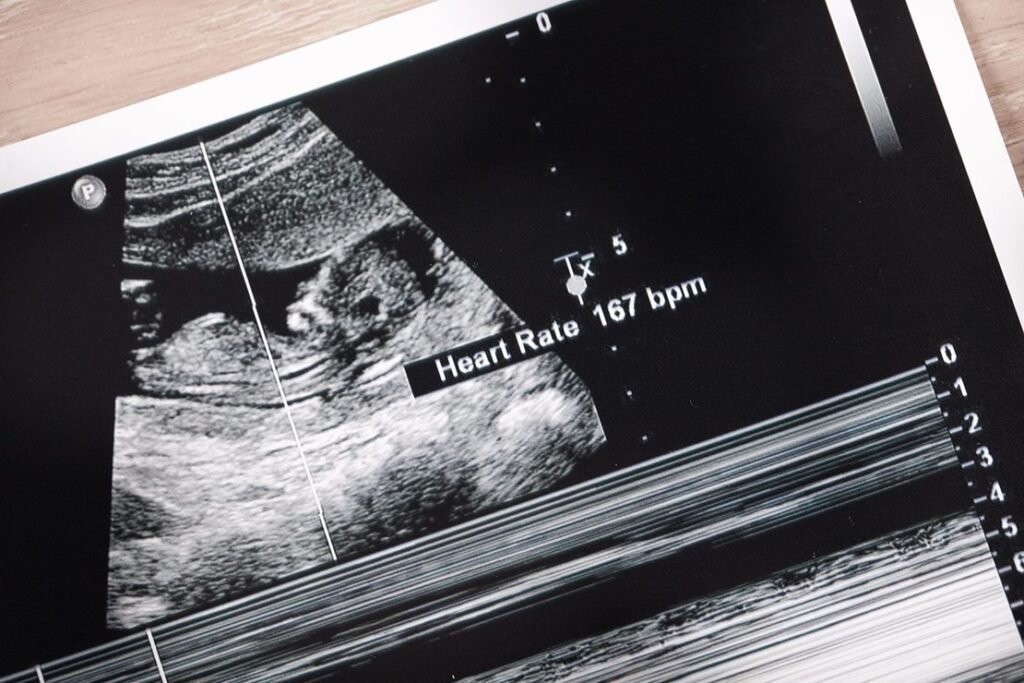Introduction
One of the most common questions expectant parents ask after hearing their baby’s heartbeat is, “Does the fetal heart rate tell me if it’s a boy or a girl?” When you see a heart rate of 158 beats per minute (BPM) on your ultrasound report, it’s easy to wonder whether that number means you’re carrying a daughter or a son. The idea that a baby’s heart rate can predict gender has been passed down for generations.
Many people believe that a faster heartbeat means a girl, while a slower one means a boy. But is there any truth behind this popular pregnancy myth? In this article, we’ll explore what medical research says, what’s considered a normal fetal heart rate, and whether there’s any connection at all between fetal heart rate and gender. By the end, you’ll know exactly what 158 BPM really means — and what it doesn’t.

What Is a Normal Fetal Heart Rate?
Before analyzing whether 158 BPM means a boy or a girl, it’s important to understand what’s normal.
A healthy fetal heart rate typically ranges between 110 and 160 beats per minute throughout most of pregnancy. Early in the first trimester, the fetal heartbeat starts lower — around 90 to 110 BPM — and gradually increases as the baby grows. By around week 9 or 10, it usually peaks between 170 and 180 BPM before settling into a stable rhythm in the normal range.
Fetal heart rate also changes throughout the day. Factors such as fetal movement, sleeping cycles, maternal stress, or even the timing of the ultrasound can cause the heartbeat to fluctuate. Doctors focus more on variability and rhythm than on a single number, since a healthy heart should speed up and slow down depending on activity.
So, a fetal heart rate of 158 BPM is perfectly normal — neither too high nor too low.
The Myth: Fetal Heart Rate Predicts Gender
There’s a popular old wives’ tale that says:
- A fetal heart rate above 140 BPM means you’re having a girl.
- A fetal heart rate below 140 BPM means you’re having a boy.
This myth has been repeated for decades by family members, friends, and even some pregnancy blogs. It’s often shared because it seems simple and sometimes appears to match personal experiences. Many mothers who had fast fetal heart rates and gave birth to girls believe it must be true. However, others with the same readings have delivered boys.
The belief likely began before modern ultrasound and genetic testing, when people relied on observable patterns and folklore to guess gender. While it’s fun to speculate, science shows there’s no reliable connection between heart rate and fetal sex.

Scientific Evidence: What Studies Say
Over the years, researchers have conducted multiple studies to find whether fetal heart rate has any correlation with the baby’s gender. The consistent finding is no significant difference between the heart rates of male and female fetuses.
One large study measured fetal heart rates during the first trimester and found almost identical averages for boys and girls. The differences were statistically insignificant — meaning they could easily happen by chance.
Other studies analyzing fetal heart rate across different weeks of pregnancy reached the same conclusion: both male and female fetuses can have fast or slow heart rates at any point.
Even when minor variations appear, they are far too small to predict gender with any accuracy. Factors like fetal activity, maternal hormones, or even the baby’s position can easily change the reading.
In short, medical research clearly shows that heart rate cannot determine whether you’re having a boy or a girl.
What Does a Fetal Heart Rate of 158 BPM Mean?
A fetal heart rate of 158 beats per minute sits near the higher end of the normal range. This is typical, especially during early or mid-pregnancy. It simply means your baby’s heart is developing and functioning well.
At certain moments, the heart may beat faster due to natural movement, oxygen changes, or fetal activity. A faster heart rate does not mean there’s a problem — and it certainly doesn’t mean your baby’s sex is one or the other.
Doctors use fetal heart rate readings mainly to monitor fetal well-being, checking for proper rhythm, accelerations, and overall variability. As long as the heart rate stays between about 110 and 160 BPM, there’s no need for concern or assumption about gender.
So, if your baby’s heart rate is 158 BPM, take it as a positive sign of a healthy heartbeat, not a gender clue.
Why This Myth Persists
Despite scientific evidence, the idea that fetal heart rate predicts gender continues to circulate. Here’s why:
- Confirmation Bias – People remember when the myth “works” and forget when it doesn’t. If a fast heart rate baby turns out to be a girl, it reinforces the belief.
- Emotional Excitement – Pregnancy is full of anticipation, and guessing the baby’s gender adds fun to the experience.
- Cultural Traditions – In many cultures, gender-predicting myths are passed down through generations as part of family storytelling.
- Lack of Early Clues – Before modern tests like ultrasounds and blood screenings, people relied on physical signs and heartbeats as one of the only visible indicators.
While it’s fun to play along with these tales, it’s best to treat them as entertainment, not evidence.

Other Myths About Predicting Baby’s Gender
Fetal heart rate isn’t the only myth around baby gender prediction. Here are a few others you might hear:
- Carrying high or low: Some say carrying high means a girl, and low means a boy — but belly shape is determined by muscle tone and body type.
- Cravings: Sweet cravings are linked to girls, salty to boys — yet cravings often come from hormonal or nutritional changes.
- Morning sickness severity: Some claim more nausea means a girl, but it’s related to hormone levels, not gender.
- Mood changes: Emotional swings are sometimes said to signal a girl, but mood is influenced by hormonal fluctuations common to all pregnancies.
Just like heart rate, these are all myths with no scientific basis. The only way to know your baby’s gender accurately is through medical testing.
Reliable Ways to Determine Baby’s Gender
If you truly want to know your baby’s sex, these medically proven methods are accurate:
- Ultrasound (18–22 Weeks):
The anatomy scan is the most common way to identify gender. A trained sonographer can usually see the baby’s genitalia during this time, though accuracy depends on the baby’s position. - Noninvasive Prenatal Testing (NIPT):
A simple blood test from the mother can detect fetal DNA and identify whether a Y chromosome (male) is present. It’s highly accurate and available as early as 10 weeks. - Chorionic Villus Sampling (CVS) and Amniocentesis:
These tests analyze fetal cells for genetic purposes and can confirm gender with certainty. However, they are typically performed for medical reasons, not just gender prediction.
If you’re curious, talk to your doctor about which method is suitable for you. These tests are safe, reliable, and far more accurate than any heartbeat myth.

The Role of Fetal Heart Rate in Pregnancy
Even though it doesn’t reveal gender, fetal heart rate is still one of the most important indicators of your baby’s health. Doctors monitor it to assess:
- Oxygen levels and fetal well-being
- Fetal distress during labor or pregnancy
- Growth and development
In some cases, an unusually high or low heart rate may signal medical concerns like infection, anemia, or umbilical cord issues — but this is rare and usually identified by your healthcare provider.
So, while heart rate doesn’t predict gender, it does play a key role in monitoring your baby’s overall health.
Read More: How to Decrease Melanin in Skin Naturally and Safely
Conclusion
A fetal heart rate of 158 BPM is a completely normal and healthy sign during pregnancy. Despite the widespread myth that heart rate can predict whether you’re having a boy or a girl, science has proven otherwise. Multiple medical studies show that there is no meaningful difference between the heart rates of male and female fetuses.
The number on your ultrasound simply reflects your baby’s activity and development — not their gender. While it’s fun to make predictions, the only accurate ways to find out your baby’s sex are through ultrasound or genetic testing. The most important thing is that your baby’s heart is strong and steady. So, rather than guessing, celebrate every heartbeat as a beautiful sign of life — and let nature surprise you when the time comes.
FAQs
1. Can a fetal heart rate of 158 BPM tell if it’s a boy or girl?
No. A fetal heart rate of 158 BPM falls within the normal range and does not indicate the baby’s gender.
2. Is 158 BPM considered a normal fetal heart rate?
Yes. Anything between 110 and 160 BPM is normal for a developing baby.
3. Why do people say a fast heart rate means a girl?
It’s an old wives’ tale passed down through generations, but scientific research does not support it.
4. When can I accurately find out my baby’s gender?
Gender can usually be determined around 18–22 weeks via ultrasound or earlier with a blood test (NIPT).
5. What does a high fetal heart rate really mean?
A higher heart rate usually reflects normal fetal activity, excitement, or growth — not gender.